Crystallising Honey
By Mike on Wednesday, March 20, 2013, 20:10 - Permalink
 Crystallised honey is regarded by many as inferior to clear or smooth set honey - indeed, tips on how to clarify crystallised honey by gently melting it are common.
Crystallised honey is regarded by many as inferior to clear or smooth set honey - indeed, tips on how to clarify crystallised honey by gently melting it are common.
But some people, like me, prefer it crystallised. So here's how to deliberately crystallise a jar of clear honey.
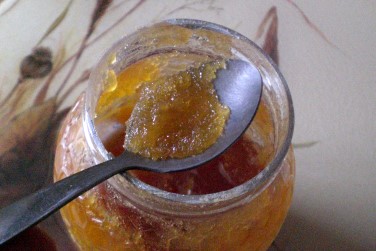
To start the process, you will need some honey crystals - I had a whole jar of crystallised honey already open, so I just used a little of this.
If you haven't got a whole jar of crystallised honey, you'll often find a few crystals around the rim of any jar of honey that's been open a while - you only need a little bit.
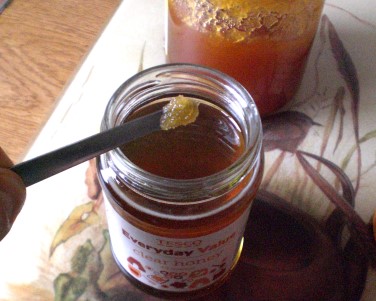 I bought a jar of cheap clear honey.
I bought a jar of cheap clear honey.
I dropped in a small spot of honey crystals from the other jar, then replaced the lid and left it overnight.
 The next day, the crystals had sunk into the top surface of the clear honey.
The next day, the crystals had sunk into the top surface of the clear honey.
At this stage, it looked as though the crystals might be in danger of just dissolving in - but I replaced the lid and left the jar alone for a week.
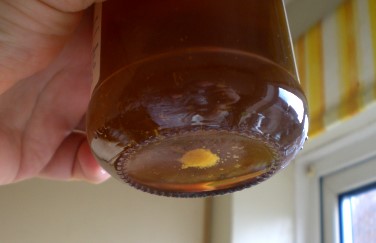 It actually took several days for the clump of crystals to sink to the bottom of the jar, where they began to spread out.
It actually took several days for the clump of crystals to sink to the bottom of the jar, where they began to spread out.
However, at the end of the first week, there wasn't any evidence of new crystals forming yet.
 At the end of week 2, a significant change has taken place.
At the end of week 2, a significant change has taken place.
There's a conspicuous layer of crystals across the entire bottom of the jar, about half a centimetre thick.
 Week 3 - maybe 2cm of pale-coloured crystals at the bottom of the jar, with a distinct lumpy cluster in the middle - still clearly growing from the initial seed crystals.
Week 3 - maybe 2cm of pale-coloured crystals at the bottom of the jar, with a distinct lumpy cluster in the middle - still clearly growing from the initial seed crystals.
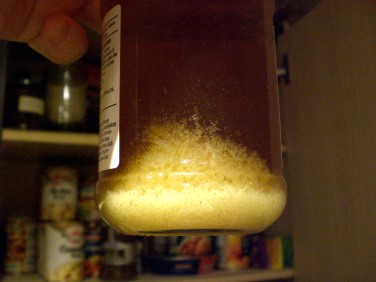 Week 5 - A spidery lattice of crystals is now growing rapidly up inside the jar.
Week 5 - A spidery lattice of crystals is now growing rapidly up inside the jar.
It's interesting how pale these are compared to the liquid honey - at a guess, I'd say there must be some sort of crude spontaneous purification process happening here - pure glucose crystallising out - this might mean that the honey flavour gets concentrated in any remaining syrup.
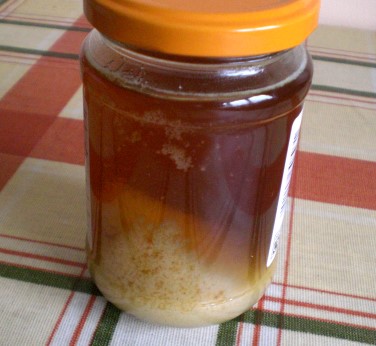 About two months since the start, and although there's quite a mass of crystallised honey at the bottom of the jar, progress seems to have slowed down a lot.
About two months since the start, and although there's quite a mass of crystallised honey at the bottom of the jar, progress seems to have slowed down a lot.
So I've moved the jar into the fridge - at a lower temperature, the saturation capacity should be reduced, and this should make the sugars start crystallising out again.
That's the extent of progress so far - this page will be updated with fresh progress on the crystallising honey jar...
(Last updated 20th March 2013)
Oops!
Looks like I didn't come back to finish writing this article (sorry!). The condensed version: The progress of crystallisation got slower and slower, but did eventually (months later) convert all of the honey to solids - and it was exactly what I had hoped for - grainy, but melt-in-the-mouth crystallised honey.
Why Does This Work?
Honey is a solution of sugars - mainly fructose and glucose - it's a supersaturated solution - this means it actually contains more sugars than could normally be dissolved into water at room temperature.
It's possible to artificially create supersaturated sugar solutions in two ways - by dissolving sugar into hot water, then cooling it, or by making a room temperature solution and then evaporating away some of the water.
The latter method is actually how bees make honey - they collect nectar from flowers, then evaporate water from it inside the hive by fanning air across it with their wings.
Supersaturated solutions will typically remain as they are until something happens to start the dissolved substance crystallising out - a speck of dust can act as a nucleation point for crystals to start growing, or a seed crystal can be introduced. In some cases, a supersaturated solution will break down if subjected to a change in pressure - such as being knocked or tapped.
